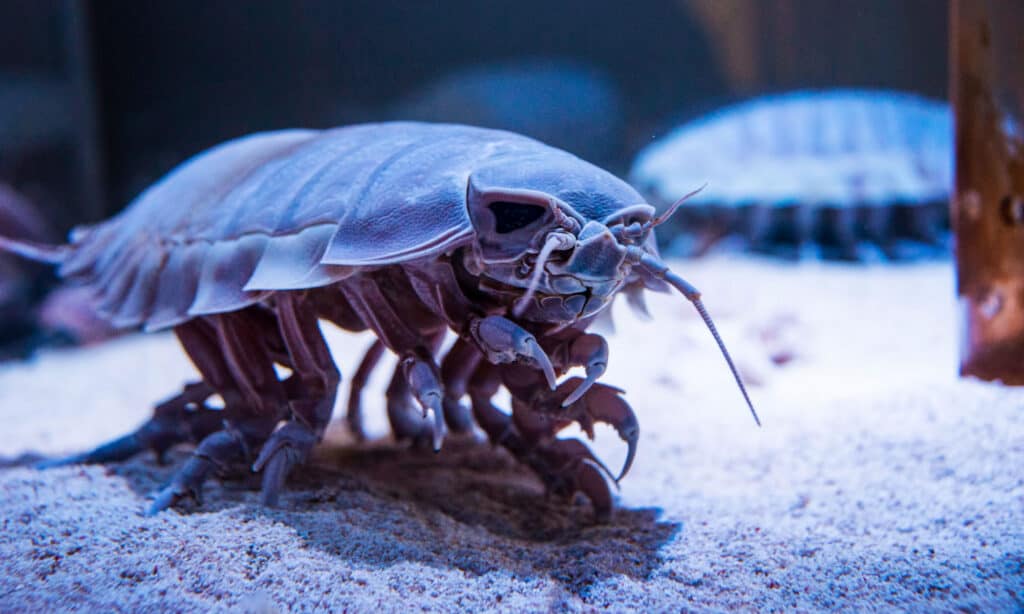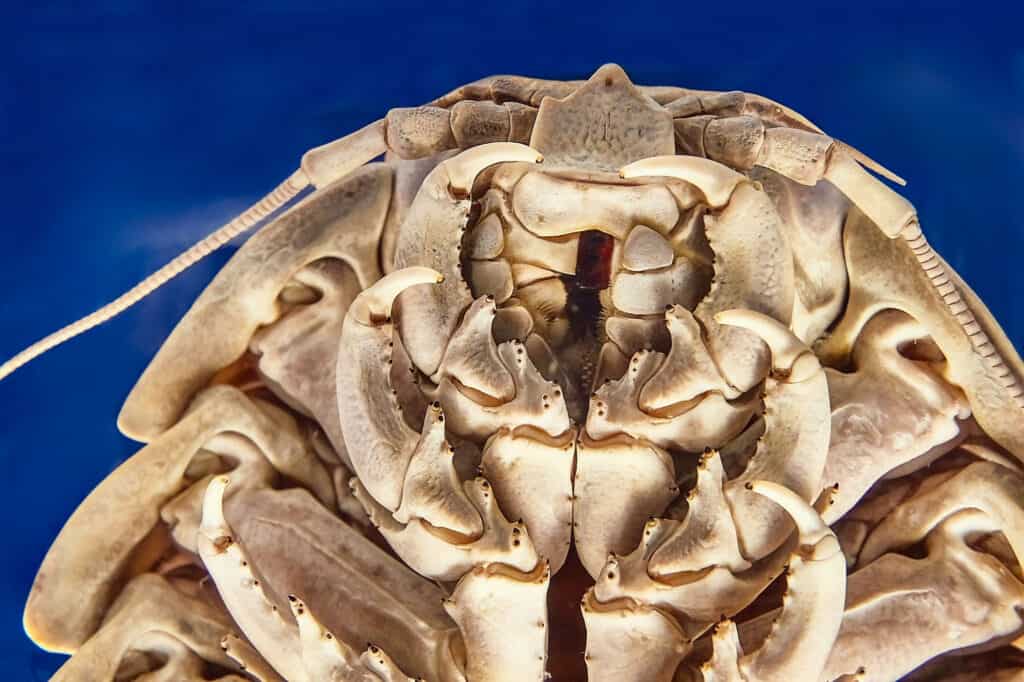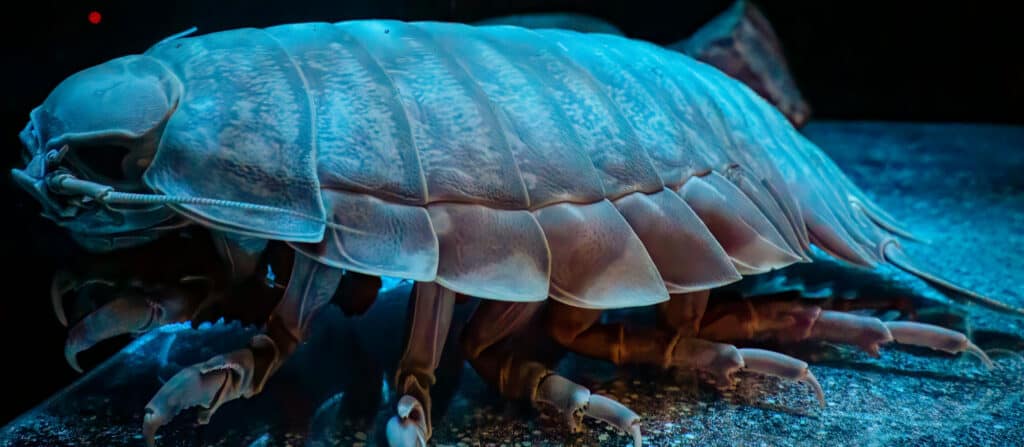Lice are normally small parasitic insects that have no wings. These parasites are found on almost every warm-blooded mammal and bird and spend most of their lives binding their eggs to hairs and feathers.
In the 19th century, scientists discovered a gigantic sea creature that grows beyond an entire foot! These carnivorous deep sea “lice” live in the darker parts of the sea where the temperatures are extremely low. Discover everything you’ve ever wanted to know about the giant deep-sea lice.
Giant Isopods: The Deep-Sea Scavengers

Giant isopods are closely related to the woodlouse.
©kikujungboy CC/Shutterstock.com
Giant isopods are aquatic isopods and are related to the woodlice, which are terrestrial isopods. They also clearly resemble woodlice, with the major differences between them being their coloring and size.
As their names imply, giant isopods are large and grow even longer than an entire foot. They are bottom-dwellers and prefer clay or muddy seafloors. This ocean level is extremely cold and dark, but giant isopods survive just fine.
They do not have great eyesight, which is inconsequential in their natural habitats due to the low lighting. Instead, they have two sets of antennae that they use to scan their surroundings. According to the Aquarium of the Pacific, scientists even suspect that they might have a sensory receptor that responds to distortion from the water surrounding them.
What Do Giant Isopods Look Like?

Giant isopods have dorsoventrally compressed bodies encased by an armor-like calcareous exoskeleton.
©Peter Gudella/Shutterstock.com
Giant isopods are found in the deep seas of the West Atlantic from off Georgia to Brazil and even the Caribbean and the Gulf of Mexico. Like woodlice, giant isopods have dorsoventrally compressed bodies encased by an armor-like calcareous exoskeleton.
They have large eyes with almost 4,000 facets spread out from each other on the head. Giant isopods also have 7 pairs of thoracic legs or pereiopods and are colored pink or pale lilac. They also have little hooked claws at the end of their legs to give them more stability as they walk.
Why Are Giant Isopods So Large?

Scientists do not know why exactly giant isopods are so large.
©iStock.com/Darren Lynch
Giant isopods are much larger than regular-sized isopods, which usually measure around 2 inches long. Isopods in this group measure anywhere from 3.1 inches to 20 inches (0.3 to 1.7 feet) long. So, why are they so long, you might wonder.
The species experienced deep sea gigantism, which enabled them to grow much larger than other animals around them. Scientists do not know what exactly causes this phenomenon, but there are multiple theories.
Some believe deep-sea gigantism is a natural mechanism to help withstand water pressure. Others believe it occurs due to food scarcity, resulting in slower sexual maturity and greater size. Another popular theory is based on Bergmann’s rule, which states that organisms of smaller sizes are found in warmer climates while larger-sized animals are found in colder locations.
How Do Giant Isopods Breathe?
Isopods that live on land have gills but also have air sacs known as pseudotrachea, which do not need to be fully submerged in water to exchange gas. This is why terrestrial isopods must live in damp or moist environments with enough water to keep them alive.
5 Fast Facts About Giant Isopods
1. Giant Isopods Have Several Relatives
Giant isopods are a group of about 20 giant crustaceans related to shrimps and crabs– albeit distantly. They, however, bear more resemblance to woodlice and even share similar defense tactics. Some other species related to giant isopods are lobsters, amphipods, krill, and barnacles.
2. Giant Isopods Are Carnivorous
Giant isopods are carnivorous scavengers and facultative predators that eat dead and living animals. They eat various fish, squid, shrimp, sponges, and animal carcasses. However, despite how non-picky they are, they can also go a pretty long while without eating. According to various sources, these isopods can go up to four years without eating anything, but when they eat, they go all in and stuff themselves so full that they cannot move.
3. Giant Isopods Live for an Average of 2 Years
According to Ocean Info, on average, giant isopods live for two years but have been recorded to live for up to five. These isopods hatch from eggs, but they aren’t laid typically as you’d expect. When pregnant, the female develops a marsupium, similar to what kangaroos have for their babies. About 20 to 30 eggs are stored in her pouch until they finally hatch.
As expected, giant isopods lay large eggs. Their eggs measure about 0.51 inches (13 mm) in diameter and are one of the largest eggs of all marine invertebrates. Surprisingly, giant isopods do not eat while pregnant, and instead, they seem to bury themselves in mud and sediment to save energy and protect their eggs.
Newly-hatched giant isopods look almost exactly like adults but are smaller in size. They measure about 3.4 inches long and lack the last pair of pereopods or limbs that adults have.
4. Giant Isopods Do Not Have Many Natural Predators
Giant isopods do not have many natural predators, which is for a number of reasons apart from where they live. Not only do they have a very hard shell that makes them hard to penetrate, but they also have very little meat and would offer very little sustenance.
However, when they are attacked, one of their defense mechanisms is to roll into a ball just like woodlice do. The Natural History Museum also states that giant isopods live more than 500 meters below the ocean surface, which reduces the number of animals that can get to them.
5. Giant Isopods Are Eaten in Asian Countries
In Asian countries, such as Japan, most giant isopods caught are mainly bycatches. However, they are eaten even though the practice isn’t extremely common, probably due to how uncommon giant isopods are.
Luckily, these isopods aren’t regarded as endangered or threatened by the International Union for Conservation of Nature; by multiple accounts, isopods are indeed a treat.
Up Next:
10 Deep Sea Creatures: Discover the Rarest Scariest Animals Beneath the Seas!
What Lives At The Bottom of The Ocean?
The photo featured at the top of this post is © iStock.com/LindaZ
Sources
- Ocean Info, Available here: https://oceaninfo.com/animals/giant-isopod/
- Aquarium of the Pacific, Available here: https://www.aquariumofpacific.org/onlinelearningcenter/species/giant_isopod
- Ocean Exploration, Available here: https://oceanexplorer.noaa.gov/facts/isopod.html
Thank you for reading! Have some feedback for us? Contact the AZ Animals editorial team.






